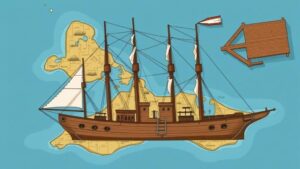Using AI to Predict Nautical Relic Finds from Historical Weather Anomalies
Using AI to Predict Nautical Relic Finds from Historical Weather Anomalies
The maritime domain is replete with remnants of human activity spanning centuries. From shipwrecks to lost cargo, these nautical relics offer invaluable insights into our past. But, locating these artifacts can be a daunting task for archaeologists and maritime historians. Recent advances in artificial intelligence (AI) have prompted researchers to explore innovative methodologies for predicting likely sites of nautical relics based on historical weather anomalies. This article delves into the methodologies employed, case studies highlighting successful implementations, and the implications of such research.
The Intersection of AI and Archaeology
AI has been increasingly integrated into archaeological practices, providing tools for pattern recognition, data analysis, and predictive modeling. Particularly in maritime archaeology, AI algorithms can analyze vast datasets involving archival records, environmental variables, and historical weather patterns to predict potential sites of interest.
- Machine Learning Models: These models utilize historical data to identify correlations between weather anomalies, such as storms or temperature fluctuations, and naval activities.
- Geospatial Analysis: AI can process geographical data to evaluate underwater topographies and potential burial sites for relics.
Historical Weather Anomalies as Predictive Indicators
Historical weather anomalies can reveal critical insights into maritime events that led to shipwrecks and the loss of cargo. Understanding these environmental factors is integral to forming a predictive model. For example, a storm system in October 1703 known as the Great Storm of 1703 caused over 8,000 shipwrecks along the southern coast of England. By analyzing the databases of ship routes and locations during this time, predictive models can be created.
Case Studies of Successful Predictive Models
Numerous case studies exemplify the viability of AI in predicting nautical relic finds. An example includes the research undertaken by the University of Southampton, which integrated AI with historical shipwreck data through machine learning algorithms.
- The Black Sea Maritime Archaeology Project: Utilizing satellite images combined with AI tools, researchers identified potential relic sites along the Black Sea floor, correlating shipwrecks with ancient weather patterns.
- The Port of San Francisco: A project combining historical records of shipping incidents from 19th-century storms with AI models resulted in the identification of previously undiscovered vessel locations.
Challenges and Limitations
While AI presents opportunities for improved predictions, challenges remain. The accuracy of predictions is heavily contingent on the quality of historical data and the algorithms used. For example, the availability of comprehensive records of past maritime activities can significantly affect outcomes. Also, underwater conditions, such as sedimentation rates and marine growth, can obscure relics over time, complicating predictions.
Real-World Applications and Implications
The integration of AI in predicting nautical relic finds not only enhances archaeological methodologies but also has broader implications for heritage management. As marine resources become increasingly stressed due to climate change and anthropogenic influences, understanding and documenting underwater cultural heritage is crucial. Predictive AI models can help prioritize areas for exploration, thereby maximizing resource allocation for archaeological teams.
Future Directions
As technology continues to evolve, the potential for AI to transform maritime archaeology is vast. Future research could benefit from the integration of augmented reality (AR) with AI to create immersive excavation experiences, allowing researchers to visualize potential relic sites as they dive. Plus, collaborative efforts between technology firms and academic institutions may yield new tools tailored specifically for archaeological purposes.
Conclusion
To wrap up, the utilization of AI to predict nautical relic finds based on historical weather anomalies shows tremendous promise. Through the synthesis of historical data and advanced technological methodologies, researchers can unveil valuable remnants of our maritime history. Investing in these predictive models can significantly enhance our understanding of historical maritime activities, informing both archaeological practices and cultural heritage preservation.

